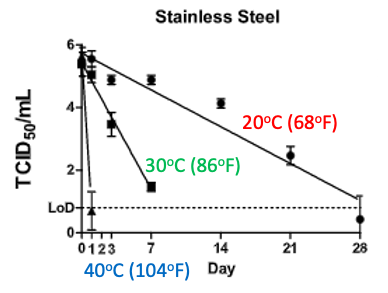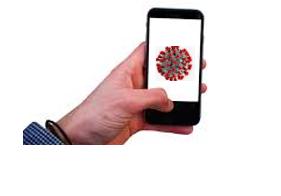A group at the Commonwealth Scientific and Industrial Research Organization (CSIRO), the national science agency of Australia, just published a study about how long SARS-CoV-2, the virus that causes COVID, can survive on surfaces at different temperatures. It's not pretty.
Shane Riddell, a Biorisk Pathogen Specialist (1), and colleagues at CSIRO measured the survival of infectious virus on different materials in different environments Depending on the nature and temperature of the surface the group found that the coronavirus can survive for about a month. Lovely.
Both the type of surface (porous vs. non-porous) and (especially) the temperature impact the survivability of the virus. Some of the results are intuitively obvious while others are just the opposite. Here is a summary of the groups' findings.
TEMPERATURE
It is not surprising that a virus would "prefer" cold temperatures, but the magnitude of the effect of temperature may be (Figure 1, below).

Figure 1. Virus survival as a function of temperature. TCID50 (Median Tissue Culture Infectious Dose) is the concentration at which 50% of the virus survives. Source: Riddell et al. Virol J (2020) 17:145 https://doi.org/10.1186/s12985-020-01418-7 .
Figure 1 shows the profound impact of temperature on virus survival on stainless steel (2). At 68oF (a chilly room) the virus survived for four weeks. But at 86oF (an uncomfortable warm room) the survival time was one week. And at 104oF (hot yoga) (3) the virus only stuck around for one day.
MATERIALS
It may seem intuitively obvious that the virus would thrive in fabrics and other porous materials and do poorly on non-porous surfaces like steel and glass, but the CSIRO group found just the opposite.
At 86oF the group was able to recover infections virus from steel and glass for 7 days, but only 3 days for cotton cloth and vinyl. Perhaps most disturbing was that the virus could be found on paper money for 21 days. Worse still, at 68 degrees infections virus could be isolated from stainless steel and glass (cell phone screens) for about a month. By contrast, influenza A can "live" for 17 days on surfaces.
WHAT DOES ALL THIS MEAN?
It is important to note that just because the virus can be isolated from surfaces for such a long time does not mean that the measured quantity of virus is infectious. The amount of virus needed for infection - the inoculum - is analogous to "the dose makes the poison" for chemicals, but not identical. If a single virion from a cellphone screen could infect people then there would be few people in the world who were spared from the disease. Although the inoculum for SARS-CoV-2 remains unknown it has been estimated that the minimum infectious dose for the virus is about 100 virus particles.
The CSIRO study is interesting in that it finds that the virus can be detected for long periods of time but it tells us little about the clinical significance of the detection. In a sense, nothing much has changed.
"Our results show that SARS-CoV-2 can remain infectious on surfaces for long periods of time, reinforcing the need for good practices such as regular handwashing and cleaning surfaces."
Debbie Eagles, MD Deputy Director of the Australian Centre for Disease Preparedness
NOTES:
(1) Pretty hard to be unemployed with these credentials.
(2) The same trend was seen for all other surfaces studied.
(3) I think I'd rather have the virus.




